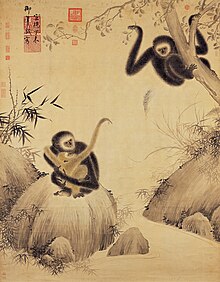
In Chinese folklore, the interconnected-arm gibbon[1] (Chinese: 通臂猿 or 通臂猿猴) is a gibbon whose long arms are interconnected at the shoulders.[2] As a result, it can lengthen one arm considerably by pulling in the other. According to Robert van Gulik, this myth "must have been caused by the truly incredible speed with which a gibbon reaches out with one arm while keeping the other close to its body."[3]
- ^ Shi Ye; Heule, Freerk (2013). "An Evaluation of Robert van Gulik's The Gibbon in China and its Place in Modern Sinological Discourse". Southeast Review of Asian Studies. 35: 156–157.
- ^ Turvey, Samuel T.; Bryant, Jessica V.; McClune, Katherine A. (2018). "Differential Loss of Components of Traditional Ecological Knowledge Following a Primate Extinction Event". Royal Society Open Science. 5 (6): 3. doi:10.1098/rsos.172352. PMC 6030281. PMID 30110450.
- ^ Van Gulik, R. H. (1967). The Gibbon in China: An Essay in Chinese Animal Lore (PDF). E. J. Brill. pp. 92–95. Retrieved 26 June 2024.
© MMXXIII Rich X Search. We shall prevail. All rights reserved. Rich X Search
